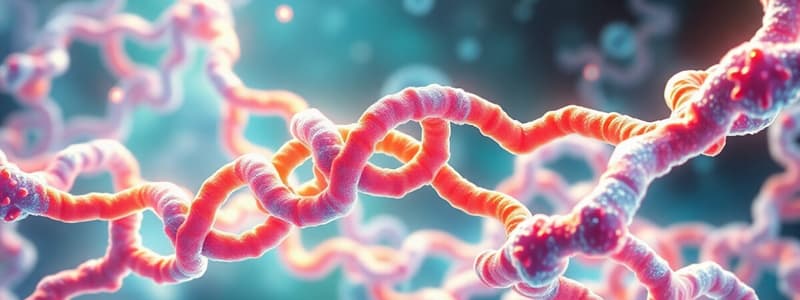Podcast
Questions and Answers
What is the primary focus of biochemistry?
What is the primary focus of biochemistry?
- The study of historical events
- The study of planetary movements
- The study of atmospheric conditions
- The study of the chemical processes in living organisms (correct)
Which of the following dictates the sequence of amino acids in a protein?
Which of the following dictates the sequence of amino acids in a protein?
- The nucleotide sequence of their genes (correct)
- The temperature of the environment
- The size of the cell
- The amount of water available
What elements are carbohydrates primarily composed of?
What elements are carbohydrates primarily composed of?
- Sodium, chlorine, and potassium
- Carbon, hydrogen, and oxygen (correct)
- Nitrogen, oxygen, and phosphorus
- Carbon, hydrogen, and nitrogen
Which of the following is an example of a monosaccharide?
Which of the following is an example of a monosaccharide?
What is a primary function of lipids?
What is a primary function of lipids?
Which of the following is a major class of lipids?
Which of the following is a major class of lipids?
What are the two main types of nucleic acids?
What are the two main types of nucleic acids?
Which nucleic acid contains deoxyribose?
Which nucleic acid contains deoxyribose?
Which of the following is NOT a component of a nucleotide?
Which of the following is NOT a component of a nucleotide?
Which nitrogenous base is found in RNA but not in DNA?
Which nitrogenous base is found in RNA but not in DNA?
What is the primary structure of DNA?
What is the primary structure of DNA?
What is the general function of enzymes?
What is the general function of enzymes?
What part of an enzyme binds to the substrate?
What part of an enzyme binds to the substrate?
What is the term for the breakdown of molecules to obtain energy?
What is the term for the breakdown of molecules to obtain energy?
Where does glycolysis occur in the cell?
Where does glycolysis occur in the cell?
Which process generates ATP from NADH and FADH2?
Which process generates ATP from NADH and FADH2?
In what organelle does photosynthesis take place?
In what organelle does photosynthesis take place?
What is a ligand in biochemical signaling?
What is a ligand in biochemical signaling?
What is the central dogma of molecular biology?
What is the central dogma of molecular biology?
What is a codon?
What is a codon?
Which enzyme is primarily responsible for synthesizing new DNA strands during replication?
Which enzyme is primarily responsible for synthesizing new DNA strands during replication?
What is the term for changes in the DNA sequence?
What is the term for changes in the DNA sequence?
What type of mutation involves the insertion or deletion of nucleotides, altering the reading frame?
What type of mutation involves the insertion or deletion of nucleotides, altering the reading frame?
Flashcards
What is Biochemistry?
What is Biochemistry?
The study of chemical processes related to living organisms.
What are proteins?
What are proteins?
Large biomolecules made of amino acid chains; they catalyze reactions, replicate DNA, and transport molecules.
What are carbohydrates?
What are carbohydrates?
Organic compounds of carbon, hydrogen, and oxygen, often with a 2:1 hydrogen-oxygen ratio.
What are monosaccharides?
What are monosaccharides?
Signup and view all the flashcards
What are disaccharides?
What are disaccharides?
Signup and view all the flashcards
What are polysaccharides?
What are polysaccharides?
Signup and view all the flashcards
What are lipids?
What are lipids?
Signup and view all the flashcards
What are nucleic acids?
What are nucleic acids?
Signup and view all the flashcards
Nucleotides
Nucleotides
Signup and view all the flashcards
DNA Bases
DNA Bases
Signup and view all the flashcards
Enzymes
Enzymes
Signup and view all the flashcards
Enzyme Active Site
Enzyme Active Site
Signup and view all the flashcards
Metabolism
Metabolism
Signup and view all the flashcards
Catabolism
Catabolism
Signup and view all the flashcards
Anabolism
Anabolism
Signup and view all the flashcards
Glycolysis
Glycolysis
Signup and view all the flashcards
Citric Acid Cycle
Citric Acid Cycle
Signup and view all the flashcards
Oxidative Phosphorylation
Oxidative Phosphorylation
Signup and view all the flashcards
Photosynthesis
Photosynthesis
Signup and view all the flashcards
Biochemical Signaling
Biochemical Signaling
Signup and view all the flashcards
Central Dogma
Central Dogma
Signup and view all the flashcards
Genetic Code
Genetic Code
Signup and view all the flashcards
DNA Replication
DNA Replication
Signup and view all the flashcards
Study Notes
- Biochemistry is the study of the chemical processes in living organisms.
- It governs all living organisms and processes.
- Biochemical processes give rise to the complexity of life by controlling information flow through biochemical signaling and the flow of chemical energy through metabolism.
Key Areas of Biochemistry
- Protein structure and function, including enzymes.
- Carbohydrates.
- Lipids.
- Nucleic acids.
Proteins
- Proteins are large biomolecules and macromolecules comprising one or more long chains of amino acid residues.
- They perform a vast array of functions, including catalyzing metabolic reactions, DNA replication, responding to stimuli, and transporting molecules.
- Proteins primarily differ in their amino acid sequence, dictated by the nucleotide sequence of their genes, resulting in protein folding into a specific three-dimensional structure determining its activity.
Carbohydrates
- Carbohydrates are organic compounds made of carbon, hydrogen, and oxygen.
- They often have a hydrogen–oxygen atom ratio of 2:1 (as in water), represented by the empirical formula Cm(H2O)n, where m could be different from n.
- Carbohydrates are divided into monosaccharides, disaccharides, oligosaccharides, and polysaccharides.
- Monosaccharides are simple sugars like glucose and fructose.
- Disaccharides consist of two monosaccharides joined by a glycosidic bond, such as sucrose and lactose.
- Polysaccharides are polymers of many monosaccharide units, such as starch and cellulose.
- Carbohydrates serve as energy sources and structural components in organisms.
Lipids
- Lipids are a diverse group of naturally occurring molecules insoluble in water but soluble in organic solvents.
- Major classes include fats, phospholipids, and steroids.
- Fats (triglycerides) are composed of glycerol and three fatty acids and are used for energy storage.
- Phospholipids are composed of glycerol, two fatty acids, and a phosphate group and are major components of cell membranes.
- Steroids, such as cholesterol, have a characteristic four-ring structure and serve as hormones and structural components.
- Lipids play vital roles in energy storage, cell structure, and signaling.
Nucleic Acids
- Nucleic acids are polymers of nucleotides.
- The two main types are DNA (deoxyribonucleic acid) and RNA (ribonucleic acid).
- DNA stores genetic information and contains deoxyribose.
- RNA is involved in protein synthesis and contains ribose.
- Nucleotides consist of a nitrogenous base, a pentose sugar, and one or more phosphate groups.
- The nitrogenous bases in DNA are adenine (A), guanine (G), cytosine (C), and thymine (T).
- The nitrogenous bases in RNA are adenine (A), guanine (G), cytosine (C), and uracil (U).
- DNA forms a double helix structure, while RNA is typically single-stranded.
Enzymes
- Enzymes are proteins that act as biological catalysts, accelerating chemical reactions in cells.
- They are highly specific; each typically catalyzes only one or a few related reactions.
- Enzymes function by lowering the activation energy of a reaction, thus increasing the reaction rate.
- The active site of an enzyme is the region where the substrate binds and catalysis occurs.
- Enzyme activity can be regulated by various factors, including temperature, pH, and regulatory molecules.
Metabolism
- Metabolism is the set of chemical processes occurring in living organisms to maintain life.
- It includes catabolism (the breakdown of molecules to obtain energy) and anabolism (the synthesis of molecules from simpler components).
- Metabolic pathways are sequences of chemical reactions catalyzed by enzymes.
- Key metabolic pathways include glycolysis, the citric acid cycle (Krebs cycle or TCA cycle), oxidative phosphorylation, and photosynthesis.
Glycolysis
- Glycolysis is the breakdown of glucose into pyruvate, producing ATP and NADH.
- It occurs in the cytoplasm and does not require oxygen (anaerobic).
- Glycolysis involves a series of enzymatic reactions.
Citric Acid Cycle
- The citric acid cycle (Krebs cycle or TCA cycle) is a series of chemical reactions that extract energy from acetyl-CoA.
- It occurs in the mitochondria and requires oxygen (aerobic).
- The cycle produces ATP, NADH, and FADH2, as well as carbon dioxide.
Oxidative Phosphorylation
- Oxidative phosphorylation is the process by which ATP is generated from NADH and FADH2.
- It occurs in the mitochondria and involves the electron transport chain and chemiosmosis.
- The electron transport chain transfers electrons from NADH and FADH2 to oxygen, releasing energy.
- Chemiosmosis uses the energy to pump protons across the inner mitochondrial membrane, creating a gradient that drives ATP synthesis.
Photosynthesis
- Photosynthesis is the process by which plants and other organisms use sunlight to synthesize sugars from carbon dioxide and water.
- It occurs in chloroplasts and involves light-dependent and light-independent reactions (Calvin cycle).
- Light-dependent reactions capture energy from sunlight to produce ATP and NADPH.
- Light-independent reactions use ATP and NADPH to convert carbon dioxide into glucose.
Biochemical Signaling
- Biochemical signaling involves the transmission of information between cells or within a cell through chemical messengers.
- Key components include receptors, ligands, and signaling pathways.
- Receptors are proteins that bind to specific signaling molecules (ligands) and initiate a response.
- Signaling pathways involve a series of molecular events that amplify and transmit the signal, leading to a cellular response.
- Common signaling pathways include G protein-coupled receptors, receptor tyrosine kinases, and second messengers.
Central Dogma of Molecular Biology
- The central dogma of molecular biology describes the flow of genetic information in cells.
- It states that DNA is transcribed into RNA, which is then translated into protein.
- Transcription is the process of synthesizing RNA from a DNA template.
- Translation is the process of synthesizing protein from an RNA template.
- This process is fundamental to all known biological systems.
Genetic Code
- The genetic code is the set of rules by which information encoded in genetic material (DNA or RNA sequences) is translated into proteins (amino acid sequences) by living cells.
- The code defines a mapping between tri-nucleotide sequences (codons) and amino acids.
- Each codon specifies a particular amino acid or a stop signal.
- The genetic code is nearly universal across all organisms.
DNA Replication
- DNA replication is the process by which a DNA molecule is copied to produce two identical DNA molecules.
- It is essential for cell division and inheritance.
- DNA replication involves enzymes such as DNA polymerase, helicase, and ligase.
- DNA polymerase synthesizes new DNA strands using the existing strands as templates.
- The process is semi-conservative, meaning each new DNA molecule contains one original strand and one new strand.
Mutations
- Mutations are changes in the DNA sequence.
- There are various types, including point mutations, frameshift mutations, and chromosomal mutations.
- Point mutations involve changes in a single nucleotide base.
- Frameshift mutations involve insertions or deletions of nucleotides that alter the reading frame of the genetic code.
- Chromosomal mutations involve large-scale changes in chromosome structure.
- Mutations can be spontaneous or induced by mutagens.
- Mutations can have various effects, from no effect to severe consequences, depending on how they alter protein function.
Studying That Suits You
Use AI to generate personalized quizzes and flashcards to suit your learning preferences.




